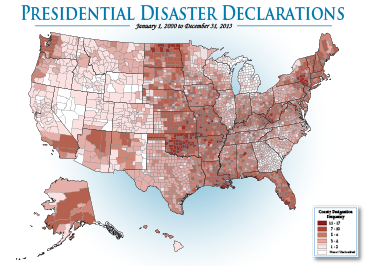
Natural Disasters
Natural disasters can include any number of weather related events and are often determined by geographical location. Fortunately, most natural disaster situations are predictable, allowing communities and individuals the opportunity to prepare prior to the event.
Preparing before a natural disaster can help to:
- Minimize the impact on you and your family
- Protect and preserve your home, farm and business
- Protect the well-being of your pets and livestock
Natural Disaster Preparedness Resources
Find information and resources to help you prepare for natural disaster situations.
| Floods | |
| Severe Thunderstorms | |
| Tornadoes | |
| Excessive Heat | |
| Drought | |
| Winter Storms | |
| Disaster Assistance | |
| Wildfires |
Additional Web Resources
A review of infectious and non-infectious hazards for animals that have previously been related to national disasters.
U.S. Department of Agriculture, Animal and Plant Health Inspection Service (USDA APHIS)
CDC's main website of resources for natural disasters and severe weather emergency preparedness and response.
Centers for Disease Control and Prevention (CDC)
Web-based database of extension resources addressing preparedness and recovery topics following a variety of hazards and disaster situations.
Extension Disaster Education Network (EDEN)
Website listing federal disaster declarations for the United States, by year or by state.
Federal Emergency Management Agency (FEMA)
Current warnings and forecasts for the United States.
National Weather Service (NOAA NWS)
Main website of resources from the EPA on planning, preparing, responding and recovering from various natural disasters and weather emergencies.
Environmental Protection Agency (EPA)
CDC main website for natural disasters preparedness and response resources.
Centers for Disease Control and Prevention (CDC)
Factsheet discussing the impact of natural disasters and the role of the USGS in monitoring and responding to these situations.
U.S. Geological Survey (USGS)
Website listing with the National Weather Radio transmitter areas (states and counties), frequencies and Specific Area Message Encoding (SAME) codes needed to receive emergency alerts.
National Weather Service (NOAA NWS)
Map showing the number of Presidential disaster declarations in the U.S. from December 1964 to March 2013.
Federal Emergency Management Agency (FEMA)
Map showing the number of Presidential disaster declarations in the U.S. from January 2000 to March 2013.
Federal Emergency Management Agency (FEMA)
Factsheet addressing health risks and hazards after a disaster situation. Includes animal and insect related hazards, carbon monoxide poisoning, food and water safety.
Centers for Disease Control and Prevention (CDC)
Website with information about weather phenomena, including tornadoes, tunderstorms, floods, and winter weather.
National Severe Storms Laboratory (NOAA NSSL)
General information regarding safety and recovery from natural disasters including storms, floods, and power outages.
Iowa State University Extension
Webpage discussing with information on a wide range of disasters and emergencies.
American Red Cross (ARC)
Website with links to information on various emergencies and how to prepare.
U.S. Department of Agriculture (USDA)
Website for Disaster Assistance Programs.
U.S. Department of Agriculture (USDA)
Tips for safely using generators as a source of electrical power.
Louisiana State University Ag Center
A map or real-time streamflow compared to historical steramflow.
U.S. Geological Survey (USGS)






